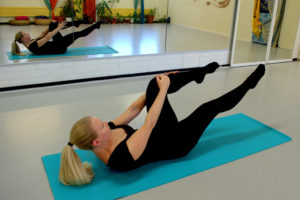Some of you that have read the Dr. McGill’s books might disagree with him in regards to what he refers to as “stiffness” and its importance in athleticism. I for one am a former martial artist that used to do splits while standing with one foot. So I understand your disbelief. When I told my shifu about my low back pain a decade ago, his suggestion was the toe touch stretch where you stand on both feet and try to reach your toes. I used to be able to touch my knees with my chin, with a straight knee. Those stretches only gave me temporary relief. So let me go though what the latest science actually says about stretching, specifically static stretching, and why I don’t do static stretching anymore.
THE PROMISES OF STRETCHING

Yes, I’m sure most of you have read many articles about the benefit of stretching. This site even said that certain yoga poses can do wonders for everything from hangover, insomnia, sugar craving, depression, to the flu. What is absent is the research behind all these claims. Keep in mind that in this world of fake homeopathy and touch healing, I for one don’t really believe in any of them unless they show me the money i.e. actual non-biased, randomized trial. And as per my previous post regarding anecdotal evidence in health, you shouldn’t believe in anecdotal evidence either.
Now as an NASM certified personal trainer, I have also been taught about all the difference between static and dynamic stretching, self-myofacial release (SMR) i.e. foam rolling stretch, etc. and which to use at which phase of the training you are in. This of course begs the question: How effective are they in real life scenario. especially for injury prevention during training and soreness reduction afterwards. For the purpose of this article, we will stick to static stretching. Mainly due to the fact that this is the most common form of stretching everybody does prior to exercise.
STATIC STRETCHING TO PREVENT SORENESS

Based on research done on Norway Knowledge Center for Health Services on stretching to prevent injury and and soreness, static stretching does nothing on risk injury. Mind you that this is a big study on 2377 adult participants that exercise regularly. It was a randomized trial with international setting. The most the researchers could positively said about static stretching is that it reduces the risk of bothersome soreness after exercise (i.e. DOMS, Delayed Onset of Muscle Soreness).
George Institute of Global Health in Australia did a study on stretching to prevent muscle soreness after exercise that combined the Norway study above along with 11 other studies to compare the result in field and lab setting. Result from both settings are consistent and the conclusion was that, nope, it does not even reduce DOMS even in healthy adults, regardless if you do it before, after, or before and after exercise.
Last but not least, another study done by University of Sydney on effects of stretching before and after exercise to reduce muscle soreness and injury reduction also showed no noticeable difference on both counts. This study compared 5 past studies, two on military recruit training.
STATIC STRETCHING TO PREVENT INJURIES

Proprioception basically means the capability of your muscles to give a feedback towards your nervous system by the way. Think about it as closing your eyes and doing squats or walking straight, your muscles should also be able to help you sense your surroundings.
So strength training, proprioception training, and stretching. From sporting point of view, which one is actually most effective in injury prevention? Based on 2014 study done by Copenhagen Institute of Sports Medicine of 25 trials regarding effective exercise interventions to prevent injuries involving 26610 participants with 3464 injuries, stretching not surprisingly showed no benefit in injury prevention, both acute and overuse injury. Proprioception and strength training on the other hand consistently showed undeniable benefit towards injury prevention in sports. That’s right not only would proper strength training gives you more Oomph during the game, it will also helps you prevent injury.
Last but not least, Joseph J Knapik of the US Army Center of Health Promotion and Preventive Medicine did a study in 2015 regarding the importance of physical fitness for Injury Prevention. His research result on military population shows that too much or too little flexibility increases injury risk. Static stretching prior to exercise does NOT reduce risk of injury but REDUCES strength and power (explosive strength) although warm up (low intensity activity prior to exercise) appears to reduce the risk of injury.
CONCLUSION
So there you have it folks. Based on studies of active recreational community up to military personnel, static stretching does not help reduce injury. It would even decrease your performance. This is no surprise since Dr. McGill’s research already indicated that too much flexibility will create instability. Motorheads also understand this well as soft suspensions with lots of travel cannot do tight corners on sports cars. What’s importance is your ROM (range of motion) and make sure you can do them properly for the range of activity of your choice. If you do Tae Kwon Do, Muay Thai and Jiu Jitsu, yes, you do need to have a very large, forward facing hip ROM and doing splits helps you achieve that. But if you are an elite marathon runner, having a tighter hamstring actually helps.

Learning so much from this blog! It’s like I’m being stripped bare of so much familiar but unproven ” knowledge” and being clothed again in really valid stuff. Thank you, Master Damien!